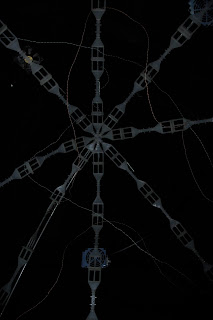Peter Pazderski
Deans Grant Proposal
Fall 2010
Artists Statement
Like many people, I spend a lot of time existing within virtual spaces, such as video games and social networks. The virtual world invades and sometimes overrides my physical world and relationships. My artwork has become a cathartic means of exorcising my own addictive tendencies to technology. This addiction is ironic given that the virtual, and the technology that enables it, has been thought of as a freeing element within our society. Donna Haraway wrote in the “Cyborg Manifesto” of a being called a Cyborg, which exists within the virtual realm that transcends race, gender and even historical ties - we are this being. Yet we have failed to achieve Haraway’s vision, instead of transcending our physical selves. Instead we, as a society, have created hyper-real, clichéd versions of ourselves. Our society has become obsessed with virtual space, not as a free space of ideas and harmony, but rather as a contained space for discord and fantasy. In digital installations and video work I explore this failure and the obsessions that lead to it. My goal is to be able to isolate the unseen forces that make virtual space such a compatible mechanism for desire and escape within our society.
To develop my understanding of virtual space I am exploring the aesthetics of immersion and interface. The primary method of this exploration in my work consists of video, because it replicates the experience of the virtual interface, and installation, is able to create an experience within the gallery that is psychologically similar to that of immersing oneself within a virtual space. My recent work focuses on the use of virtual space as a tool to create ‘shadow personalities’. Using the idea of the shadow, as defined by Jungian psychology, we can understand avatars and other virtual identities as not only idealized virtual representations, but also as conduits for realizing our own unconscious selves which we may or may not wish to acknowledge. By understanding 'shadow personalities' I hope to explore some of the more damaging effects virtual space can have on the human psyche.
Project Proposal
For my terminal project, Virtual Bodies, I plan to build an immersive digital video installation that combines the realm of the virtual, physical and hypothetical. In this digital installation I will explore ideas of the post-human and virtual identity. Looking at artists like Stelarc,Steve Mann and Simon Penny, I am thinking about the use of technology as extension and augmentation of the human body. As an artificial arm or eyes are augmentations of a physical body, in my piece, Virtual Bodies, I am focusing on the creation of virtual identity as an augmentation of the human psyche. In my immersive digital video installation, the viewer will become a participant in the creation of their own virtual identity, merging the world of the physical presence with those of the virtual identity and the hypothetical being of the 'shadow personality'.
When visualizing Virtual Bodies I began by thinking of what avatars and virtual identities are used for, what is there purpose? I continually returned to the idea of escapism, the idea of using virtual space as an escape mechanisms appealed to me in both a personal and cultural sense. This led me inexplicably to the idea of 'escape pods', specifically those found in science fiction movies and TV shows. These objects of our cultural imagination are perfect tools for discussing virtual identities, not only as escape mechanisms but also as functional conduits of travel. In science fiction 'escape pods' are used to run away from a dire situation, or as in the instance of Star Wars, to preserve some vital piece of data.
In creating my 'escape pod' I am trying to overlap the physical space of the body, virtual space and the hypothetical space of the psyche. To accomplish this each space needs to be represented and activated. The physical space will be activated by the 'escape pods' physical presence, which will be a geo-sphere constructed of steel piping, large enough to hold one full grown adult, suspended from the ceiling. The interior of the sphere will be wrapped within a black cloth that will block light and sound from outside the sphere. When entering the sphere, through a small passage on its side, the viewer will become more aware of their physical presence, because of the claustrophobic size of the space as well as the slight swaying caused by its suspension. The virtual space of the sphere will be present in a series of projections from outside the sphere which will be projected into the space through small openings in the cloth. These projections will be of instances where the creation of virtual identity will happen, the creation of an avatar in video games, profile pages on social websites and references to the virtual identities present within science fiction realm. These will overlap not only each other, but also with the viewers themselves. Interaction will happen in the virtual space through a series of sensors; motion, light and sound, which will register the viewers position and reactions and manipulate the virtual space accordingly. Viewers will interact with the physical light of the projections themselves as they enter the space and the projections become activated by the viewer's presence. The final space of the hypothetical is created within the viewers mind as they register the reaction of the space to their presence within it. By combining the actual space of the sphere, the virtual space of the projections, and the hypothetical space created within the mind of the viewer, I will create a singularity of thought and consciousness, which idealizes the actual creation of a ‘shadow personality’ within real space. Thank you for your time and consideration.









